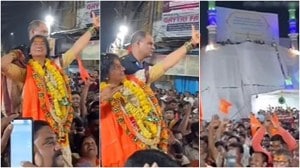- India
- International
Chandigarh: Paralysed on the road
Home to one of the highest per capita vehicular population in the country, the tricity roads are increasingly getting choked, laying to waste both fuel and man-hours. But the administration is yet to drive home a solution that suits both its pockets and the stakeholders.
 In a jam: Traffic snarls on Madhya Marg in Sector 26 (top) and at Kalagram lightpoint in Chandigarh. (Express photo)
In a jam: Traffic snarls on Madhya Marg in Sector 26 (top) and at Kalagram lightpoint in Chandigarh. (Express photo)
CHANDIGARH’S CREATOR Le Corbusier had famously said, “One day people will come to Chandigarh to see parks wherein one does not see an automobile, where one sees the nature (a very impressive nature).” But City Beautiful, designed as a cyclist’s haven, today has the highest per capita number of vehicles in the country and its neighbourhood parks, specially in the southern sectors, have turned into parking lots.
Traffic jams, once a rarity on its wide boulevards, have today become a routine. Last week, the UT traffic police’s plan to decongest the Chandigarh-Panchkula stretch fell flat thanks to the large number of vehicles that jammed Madhya Marg, the city’s main artery. In August 2018, a report by Centre for Science and Research had concluded that Chandigarh was the second worst among 14 cities in “per travel trip emissions” due to high usage of personal vehicles. The share of car usage was close to 80 per cent in the city as compared to Lucknow (70 per cent), Ahmedabad (65 per cent) and Jaipur (60 per cent).
On a vehicular high
The vehicle registration in the city has seen a manifold increase. In 2018, in a period of one year from January 1 to December 31, the city saw a registration of 45,278 vehicles, including 28,132 two-wheelers and 16,999 four-wheelers with the Registration and Licensing Authority (RLA). It means, Chandigarh witnessed an addition of 124 vehicles per day last year.
Only nine motorized cycles were registered. In 2001, the number of cars in the city stood at 7,643, while the number of two-wheelers was pegged at 14,982. From 2000 to 2017, 6,72,113 vehicles were added to the city which has a
population of 10.55 lakh as per the 2011 census.
More than 86 per cent of households own at least one car or two-wheeler. At present, public transport makes for only 16 per cent of total motorized person trips which is much lower than that recommended in the National Urban Transport Policy. A survey conducted by M/S Rites in 2008 found that the daily total inter-city passenger traffic within the Chandigarh Urban Complex was 4.93 lakh trips (cars, two-wheelers, auto rickshaws and buses) about 1.41 lakh of which comprised “through trips” which is 28.7% of the total traffic. Experts say the number of through-trips have spiked in the last 10 years due to non-availability of quality public transport, record per capita personal vehicles and absence of any outer regional connection via rail or road.

To strengthen public transport, which is the need of the hour, the transport department of UT had decided to provide “end- to-end” journey under the “last mile connectivity”project. As per this, e-rickshaws were to be made available at all bus stops to drop the passengers to their destinations. This was a counter to radio and web-based cabs offering doorstep facilities. The project found a mention even in the mobility plan presented in the meeting of NITI Ayog chaired by PM Narendra Modi, but all in vain.
Ring road only on papers
As per a study of the daily (24 hour) traffic at the outer cordon points, about 1,52,650 vehicles enter or leave Chandigarh on a typical working day. There is also a high volume of passenger and freight traffic across the city. Madhya Marg is the worst affected road since it provides the shortest and most direct connection between the towns of Mullanpur/Kharar/Anandpur Sahib and Baddi in Himachal Pradesh on the West and the towns of Manimajra, Panchkula, Pinjore, Kalka, Chandimandir Cantonment in the east.
A ring road was planned to provide an alternative route for these vehicles in transit. Talks with Punjab and Haryana governments are already on but there has been no action on the ground. UT officials said the process involves land acquisition in Punjab and Haryana and for that talks are on.
Now commuters from Zirakpur and parts of Panchkula are pinning their hopes on the Tribune flyover to decongest traffic. Though the union ministry of transport has given the green signal to it, the project has been criticized by city-based architects. The flyover, they said, not only violates the city’s character but only accommodates more vehicles instead of finding a long-term solution by promoting non-motorized transport. The tender for the construction of flyover is yet to be floated.
Suburban rail service
Road safety advisor Navdeep Asija had suggested a suburban regional rail network on the lines of Mumbai trains to deal with both heavy intercity traffic and intra-city traffic. He argued that the emergence of the new satellite towns such as New Chandigarh (Mullanpur), Kharar, Kurali, Zirakpur, Naya Gaon in Punjab; and Panchkula, Pinjore, Mansa Devi, Kalka in Haryana are likely to generate new travel corridors exerting further pressure on the region’s road network.
In the absence of any outer regional connection for these townships, the Mohali and Chandigarh city roads, which provide the shortest travel distance between these towns, are already under extreme pressure. The proposed suburban regional train network let people live in satellite towns and commute safely and easily without putting any pressure in the road network.
As per the “Regional Plan 2008-2058” for these towns under Greater Mohali Area Development Authority(GMADA), the peak hour trips, including both intercity and intra-city, are about 13.13 lakh persons/hour. It is estimated that 3.94 lakh inter-city trips are taking place between these satellite towns and using Mohali-Chandigarh city for “through-trips”. At a speed of 80 km per hour with 10 stations and stoppage time of 1 minute, the suburban train will cover one loop in maximum 1 hour and 30 minutes. Experts say the project will be an “economical, safe and efficient way to travel between these satellite towns”.
“The proposed GMADA -Tricity Suburban Regional Rail will provide a safe, economical and efficient connectivity between Chandigarh-Zirakpur-Mohali-Kharar-Gharuan-Kurali-New Chandigarh, and Siswan-Baddi via Sandholi within the Punjab state boundary and all other important towns of the region,” says Asija.
Can be ready in a year
The network also doesn’t require much work. Asija says that out of the total 108 km route proposed, 65km fully electrified route is already operational, for another 20km (Chandigarh-Baddi) construction and land accusation is underway by the Northern Railway (within Haryana). “With the construction of just 23km missing link between Kurali and Baddi via Majri-Palanpur-New Chandigarh-Siswan- Sandholi, we will get seamless regional connectivity (20km in Punjab and 3 km in Himachal). If the state governments and the Centre agree, this project can be made operational within a year’s time.”
The project report says specifies that both clockwise and anti-clock wise movement of the local trains would help decongest the Mohali-Chandigarh-Panchkula stretch being used for such inter-city trips. A well-planned regional rail system will have the capacity to move 25,000-30,000 passengers per hour in both directions each. At present, commuters are choking the roads by using private transport.
Experts claim that this project can be executed by the Railways at just 7%-8% of the cost of the proposed Chandigarh Metro without causing any financial burden to the state’s exchequer. This rail network will also help in reducing the number of accidents in the townships on the Punjab side.
At present, the risk of accidents on these roads is four times more than in the rest of Punjab, states the report.
It will also prove to be a boon for Baddi, which is home to 4,000 industrial units that employ their staff largely from Punjab. This project will facilitate their movement as well as movement of labour and goods by connecting it with two other regional industrial hubs of Mohali and Chandigarh.
The cost
The estimated cost of laying an electrified railway track in India is around 13 crore/km, excluding the cost of rolling stock and station building/upgradation. The government will need to acquire around 200 acres. It will also necessitate one major bridge on river Satluj. The overall project cost is likely to be around Rs 1,000 crore, excluding the cost of rolling stock.
Smart transport
Under the smart city project, World Bank has promised to support Chandigarh Transport Undertaking(CTU) in its modernization project with a loan of Rs 13 crore. Under this plan, all the services of CTU are to be IT-enabled and screens will be put up at all bus stops and bus stands displaying real-time arrival and departure of buses. But the project is yet to see the light of day.
Apr 18: Latest News
- 01
- 02
- 03
- 04
- 05






































